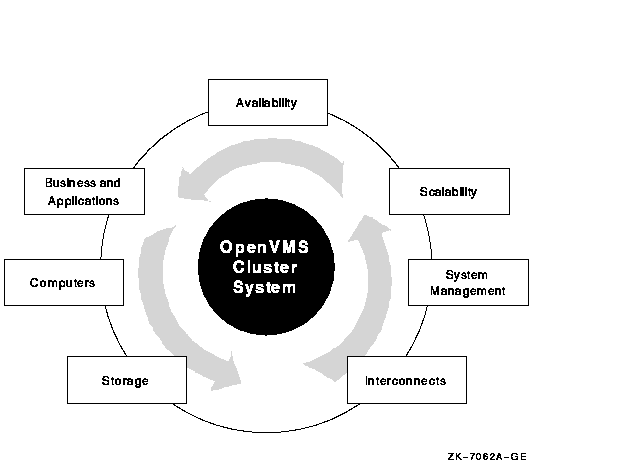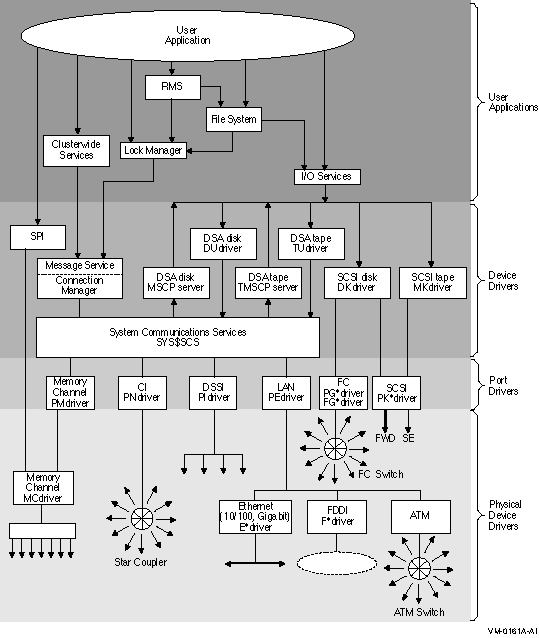HP OpenVMS Systems Documentation |
|
Guidelines for OpenVMS Cluster ConfigurationsOrder Number: AA--Q28LE--TK
November 2001
OpenVMS Cluster availability, scalability, and system management benefits are highly dependent on configurations, applications, and operating environments. This guide provides suggestions and guidelines to help you maximize these benefits. This version of Guidelines for OpenVMS Cluster Configurations is identical to the April 2001 version except for the addition of index entries to Section 7.5, Fibre Channel Tape Support. Revision/Update Information: This manual supersedes Guidelines for OpenVMS Cluster Configurations Version 7.2-1.
Software Version:
OpenVMS Alpha Version 7.3
Compaq Computer Corporation
© 2001 Compaq Computer Corporation COMPAQ, VAX, VMS, and the Compaq logo Registered in the U.S. Patent and Trademark Office. OpenVMS is a trademark of Compaq Information Technologies Group, L.P. in the United States and other countries. Motif, OSF/1, and UNIX are trademarks of The Open Group in the United States and other countries. Microsoft, MS-DOS, Visual C++, Windows, and Windows NT are trademarks of Microsoft Corporation in the United States and other countries. All other product names mentioned herein may be the trademarks of their respective companies. Confidential computer software. Valid license from Compaq required for possession, use, or copying. Consistent with FAR 12.211 and 12.212, Commercial Computer Software, Computer Software Documentation, and Technical Data for Commercial Items are licensed to the U.S. Government under vendor's standard commercial license. Compaq shall not be liable for technical or editorial errors or omissions contained herein. The information in this document is subject to change without notice. Compaq shall not be liable for technical or editorial errors or omissions contained herein. The information in this document is provided "as is" without warranty of any kind and is subject to change without notice. The warranties for Compaq products are set forth in the express limited warranty statements accompanying such products. Nothing herein should be construed as constituting an additional warranty.
ZK6318 The Compaq OpenVMS documentation set is available on CD-ROM.
PrefaceThis document can help you design an OpenVMS Cluster configuration to suit your business, application, and computing needs. It provides information to help you choose systems, interconnects, storage devices, and software. It can also help you combine these components to achieve high availability, scalability, performance, and ease of system management. Intended AudienceThis document is for people who purchase or recommend the purchase of OpenVMS Cluster products and for people who configure OpenVMS Cluster systems. It assumes a basic understanding of computers and OpenVMS Cluster concepts. About This GuideOpenVMS Cluster systems are designed to act as a single virtual system, even though they are made up of many components and features, as shown in Figure 1. Figure 1 OpenVMS Cluster System Components and Features 
Understanding the components and features of an OpenVMS Cluster configuration can help you to get the most out of your cluster. Table 1 shows how this guide is organized to explain these cluster concepts.
Related DocumentsFor additional information on the topics covered in this manual, refer to the following documents:
For additional information about the OpenVMS products and services, access the Compaq World Wide Web address:
Reader's CommentsCompaq welcomes your comments on this manual. Please send comments to either of the following addresses:
How To Order Additional DocumentationUse the following World Wide Web address to order additional documentation:
If you need help deciding which documentation best meets your needs, call 800-282-6672). ConventionsVMScluster systems are now referred to as OpenVMS Cluster systems. Unless otherwise specified, references to OpenVMS Clusters or clusters in this document are synonymous with VMSclusters. In this manual, every use of DECwindows and DECwindows Motif refers to DECwindows Motif for OpenVMS software. The following conventions are also used in this manual:
Chapter 1
|
| Benefit | Description |
|---|---|
| Resource sharing | Multiple systems can access the same storage devices, so that users can share files clusterwide. You can also distribute applications, batch, and print-job processing across multiple systems. Jobs that access shared resources can execute on any system. |
| Availability | Data and applications remain available during scheduled or unscheduled downtime of individual systems. A variety of configurations provide many levels of availability up to and including disaster-tolerant operation. |
| Flexibility | OpenVMS Cluster computing environments offer compatible hardware and software across a wide price and performance range. |
| Scalability | You can add processing and storage resources without disturbing the rest of the system. The full range of systems, from high-end symmetric multiprocessing (SMP) systems to smaller workstations, can be interconnected and easily reconfigured to meet growing needs. You control the level of performance and availability as you expand. |
| Ease of management | OpenVMS Cluster management is efficient and secure. Because you manage an OpenVMS Cluster as a single system, many tasks need to be performed only once. OpenVMS Clusters automatically balance user, batch, and print work loads. |
| Open systems | Adherence to IEEE, POSIX, OSF/1, Motif, OSF DCE, ANSI SQL, and TCP/IP standards provides OpenVMS Cluster systems with application portability and interoperability. |
An OpenVMS Cluster system comprises many hardware components, such as systems, interconnects, adapters, storage subsystems, and peripheral devices. Table 1-2 describes these components and provides examples.
| Components | Description | Examples |
|---|---|---|
| System |
A cabinet that contains one or more processors, memory, and
input/output (I/O) adapters that act as a single processing body.
Reference: See Chapter 3 for more information about OpenVMS systems. |
OpenVMS Cluster systems can contain any supported Alpha, VAX, or MicroVAX system, including SMP systems. |
| Interconnect |
The hardware connection between OpenVMS Cluster nodes over which the
nodes communicate.
Reference: See Chapter 4 for more information about OpenVMS Cluster interconnects. |
An OpenVMS Cluster system can have one or more of the following
interconnects:
|
| Storage subsystems |
Devices on which data is stored and the optional controllers that
manage the devices.
Reference: See Chapter 5 for more information about OpenVMS storage subsystems. |
Storage subsystems can include:
|
| Adapter |
Devices that connect nodes in an OpenVMS Cluster to interconnects and
storage.
Reference: See Chapter 4 for more information about adapters. |
The following adapters are used on Peripheral Component Interconnect
(PCI) systems:
|
| Peripheral devices | Devices that provide input to and produce output from a system. |
Peripheral devices include:
|
OpenVMS Cluster system software can be divided into the following types:
The operating system manages proper operation of hardware and software components and resources.
Table 1-3 describes the operating system components necessary for OpenVMS Cluster operations. All of these components are enabled by an OpenVMS operating system license or an OpenVMS Cluster license.
| Component | Function |
|---|---|
| Record Management Services (RMS) and OpenVMS file system | Provide shared read and write access to files on disks and tapes in an OpenVMS Cluster environment. |
| Clusterwide process services | Enables clusterwide operation of OpenVMS commands, such as SHOW SYSTEM and SHOW USERS, as well as the ability to create and delete processes clusterwide. |
| Distributed Lock Manager | Synchronizes access by many users to shared resources. |
| Distributed Job Controller | Enables clusterwide sharing of batch and print queues, which optimizes the use of these resources. |
| Connection Manager | Controls the membership and quorum of the OpenVMS Cluster members. |
| SCS (System Communications Services) | Implements OpenVMS Cluster communications between nodes using Compaq's System Communications Architecture (SCA). |
| MSCP server | Makes locally connected disks to which it has direct access available to other systems in the OpenVMS Cluster. |
| TMSCP server | Makes locally connected tapes to which it has direct access available to other systems in the OpenVMS Cluster. |
Figure 1-1 shows how the hardware and operating system components fit together in a typical OpenVMS Cluster system.
Figure 1-1 Hardware and Operating System Components

| Next | Contents | Index |